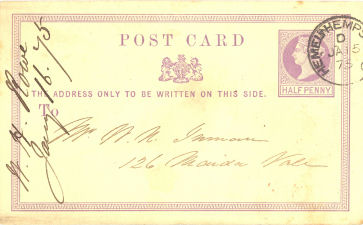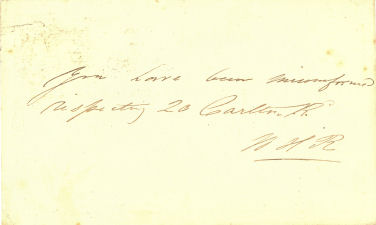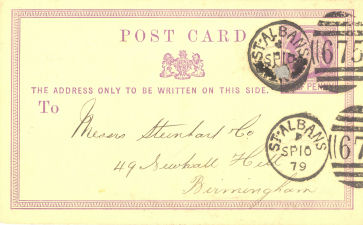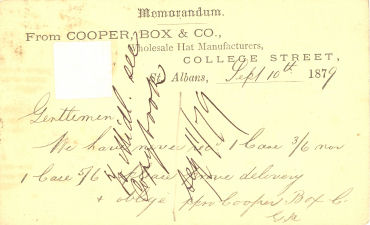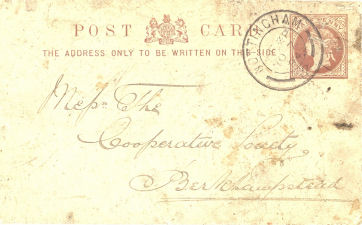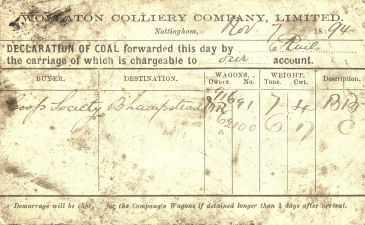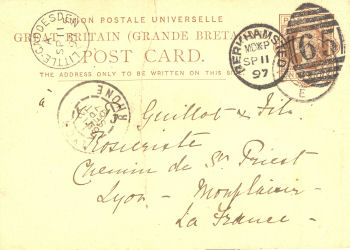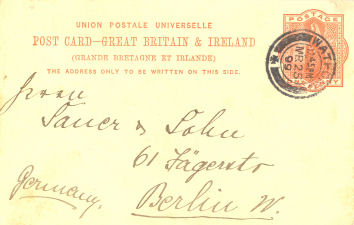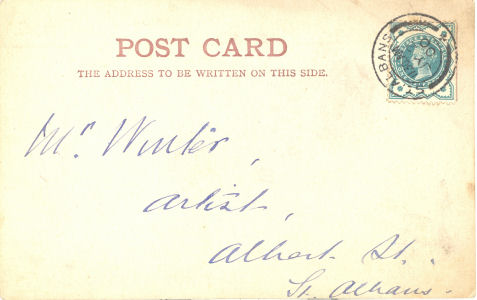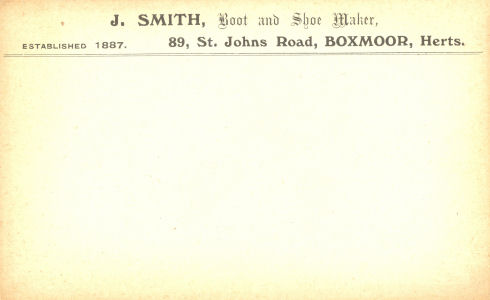|
Hertfordshire Post Card History Pre-picture Post Cards |
Early post cards were small cards, blank on one side, and a stamp printed on the on the address side. They were first produced in 1870 and cost ½d each, but after 1872 were sold at 6½d a dozen. Commercial firms could buy them in bulk and print their own information on the blank side. Some of these commercial cards would include pictures of the good being advertised.
|
|
|
|
|
This early example of a plain-backed card was sent by William Henry Rowe, the farmer at The Tunnels Farm, Gaddesden Row, Great Gaddesden, in 1881. He moved there in about 1872 after marrying Rosa Dickinson, daughter of George and Susannah Dickinson, of Cheapside Farm, Sandridge. The card was posted to a Mr N R Inmani?, of 126 Maida Vale and significance of the message "You have been misinformed respecting 20 Carlton Road" is unclear. Possibly Mr Rowe owned the property.
|
||
|
|
|
|
|
This is an example of a commercially printed card, which has a standard letter type heading printed on it. It is from Cooper, Box & Co., Wholesale Hat Manufacturers, of College Street, St Albans, and was sent in 1879 to Messrs Steinhart & Co., 49 Newhall Street, Birmingham, complaining about the non-delivery of goods. The Company is listed in the 1878 Hertfordshire Directory as simply "Cooper, Box & Co, Str. hat ma. College Street" but the 1880 flotation as a limited company states: "The Company has been formed for the purpose of taking over, carrying on, and extending the business of Messrs Cooper, Box, and Co., Wholesale and Export Hat Manufacturers, Clothiers, and Waterproofers, of Queen Victoria Street and Laurence Pountney Lane, London, and St. Albans, Hertfordshire." Steinhart and Co are listed at 63 Newhall Street , Birmingham, as Leather Case & Fancy Leather Goods Manufacturers in White's 1875 Birmingham Directory. [In 1903 there was a disastrous fire at Messrs Cooper, Box & Co’s straw plait factory at St Albans in which the premises were completely gutted and the entire stock destroyed, involving loss to the extent of several thousand pounds. Herts Almanac for 1904]
|
||
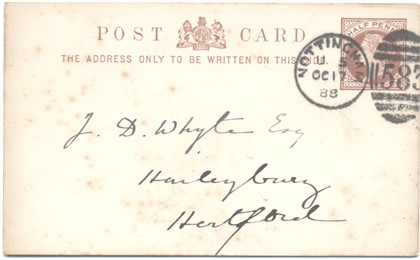 |
This card was sent in October 1888 to J. D. Whyte at Haileybury, Hertford. | |
|
|
|
|
|
This later example show a specially designed form which Wollaton Colliery Co. Ltd. use to notify customers, in this case the Berkhamsted Cooperative Society, that two MR (Midland Railway) coal wagons had been dispatched by rail to Berkhamsted.
|
||
|
[click on cards to see other side] |
||
|
In addition to the ½d cards for use for inland mail cards was produced for overseas mail from 1875. The one on the left was sent from Little Gaddesden in 1897 and the one on the right from Watford to Berlin in 1899. As can be seen the two cards are of slightly different shape. |
||
|
In 1895 there was an important change in that postage stamps could be used, rather than having a printed stamp. By 1899 what became, for many years, the standard size of 5 by 3 inches was accepted, and the cards carried the words "POST CARD - The Address to be written on this side." |
||
| This card was sent in 1900 by T. Oakley, Son & Co., The St Albans Supply Stores, St Albans to Mr Winter, artist, Albert Street, St Albans, to say that a Mr. Fewell will call tomorrow. Thomas Oakley was an important St Albans businessman and was Mayor in 1898. Mr Fewell is undoubtedly Harry J Fewell, who in the 1901 census is shown as a 31 year old grocer's assistant living at 75 Sopwell Lane, St Albans. Holmes Winter was an artist who did many sketches and paintings of old buildings - and produced a series of 100 etchings Last of Old St Albans. | ||
|
A typical standard sized business post card for a small business. This could have been printed almost any time between 1899 and 1926.
In 1881 James Smith was a bootmaker living with his widowed mother in Apsley. He married and was in St Johns Road, Boxmoor in the 1891, 1901 and 1911 censuses, and listed in trade directories until 1926. |
|
October 2013 |
Page Created |

